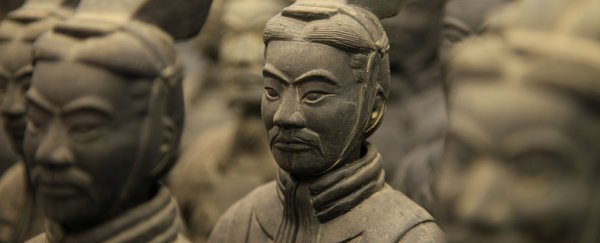For more than 2,000 years, the terracotta cavalryman statue guarded the tomb of China's first emperor, surviving centuries underneath the ground.
Then, in December, a man in an ugly sweater took his thumb.
And a selfie.
The FBI arrested a suspect, 24-year-old Michael Rohana, last week, saying he stole the ancient statue's thumb after sneaking into the terracotta warrior exhibit at Philadelphia's Franklin Institute during a "science after-hours event".
It was an ugly-sweater party, according to an arrest affidavit the FBI submitted in federal court.
News of Rohana's alleged assault on the 210 BCE-era statue has angered China, which reveres the thousands of terracotta warrior statues as treasured cultural artifacts.
On Monday, a man identified in the Beijing Youth Daily as the director of the Shaanxi Provincial Cultural Relic Exchange Center told the newspaper he hoped the United States would "severely punish" the perpetrator, who he said had "undermined and robbed the human cultural heritage".
Rohana, who lives in Delaware, has been charged with theft of an object of cultural heritage from a museum, concealment of that object and interstate transportation of stolen goods.
His attorney wasn't immediately available for comment, though the FBI affidavit says Rohana confessed to being the man seen on video sleuthing through the exhibit with a cellphone flashlight on the night of 21 December 2017.
The terracotta cavalryman statue Rohana targeted was valued at US$4.5 million, the FBI said. It was a US$5,000 thumb.
The terracotta warrior statues at the Franklin Institute were on loan from China for a special exhibit that began in September 2017.
On its web page for the exhibit, the Franklin Institute describes the statues as "one of the most significant archaeological discoveries in history", one that captivated the world when farmers in China stumbled upon an army of more than 8,000 terracotta warriors beneath the dirt while digging a well in 1974.
China's first emperor, Qin Shi Huang, had taken the army with him because he believed he would continue to rule in the afterlife, historians say. He was a big believer in immortality, building himself an enormous mausoleum akin to a small underground empire before his death in 210 BCE.
The excavation site, in Xian, has drawn in hundreds of thousands of visitors per year, while the terracotta warriors have traveled to museums across the globe.
No one was supposed to see them at the Franklin Institute on the night of the science after-hours event.
But according to the FBI affidavit, museum surveillance video captured a man in a Phillies ball cap and a green – presumably ugly – sweater disregard the black rope blocking the entrance to the exhibit at 9:08pm. He left briefly to go get his friends.
Returning, the man used his cellphone as a flashlight as he stepped up onto a platform where a calvaryman stood, put his arm around the statue, then took a selfie with it.
He put his left hand on the statue's hand, "appeared to break something off the Cavalryman's left hand and put it in his front left pocket", wrote Special Agent Jacob B. Archer, of the FBI's Art Crime Team.
On 22 December 2017, Rohana allegedly sent a Snapchat showing the "finger" he took from "a clay warrior".
Franklin Institute staff didn't discover that the thumb was missing until 8 January 2018, according to the affidavit. By the following week, the FBI had identified Rohana, went to his house and asked, in the presence of his father, "if he had anything he wanted to turn over to the FBI".
Rohana took the agent upstairs and showed him the missing thumb, which he pulled out of his desk drawer, the affidavit said.
The Franklin Institute said in a statement that a security contractor failed to follow "standard closing procedures" on the night Rohana took the finger, behavior the museum called "deplorable".
"As a result of this incident we have thoroughly reviewed our security protocol and procedures, and have taken appropriate action where needed," the statement said.
The Chinese official with the Shaanxi Provincial Cultural Relic Exchange Center told the Beijing Youth Daily that it planned to send two experts to the United States to assist in repairing the statue.
Rohana was freed on a US$15,000 personal recognizance bond on 13 February 2018.
2018 © The Washington Post
This article was originally published by The Washington Post.
